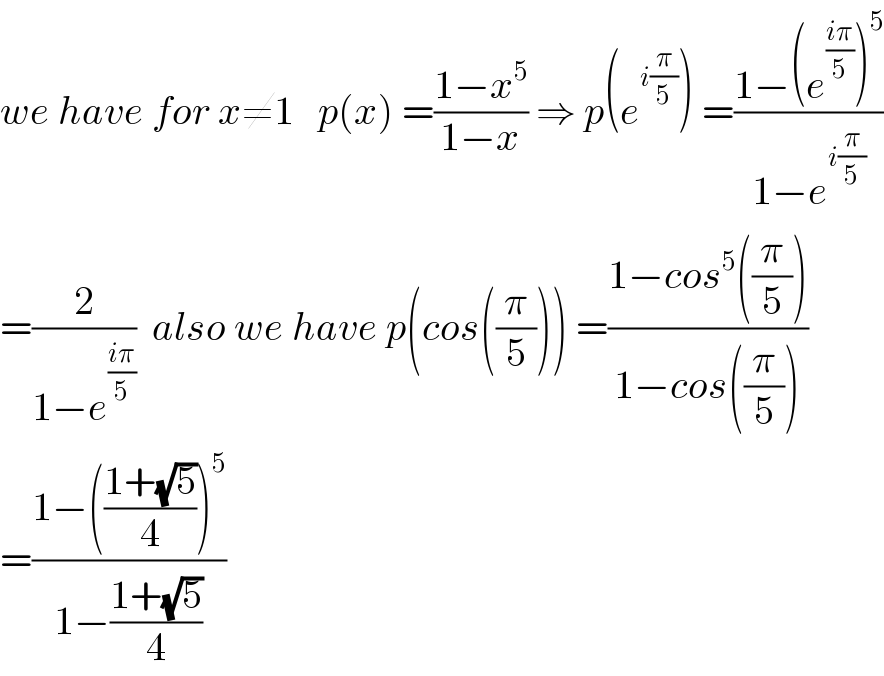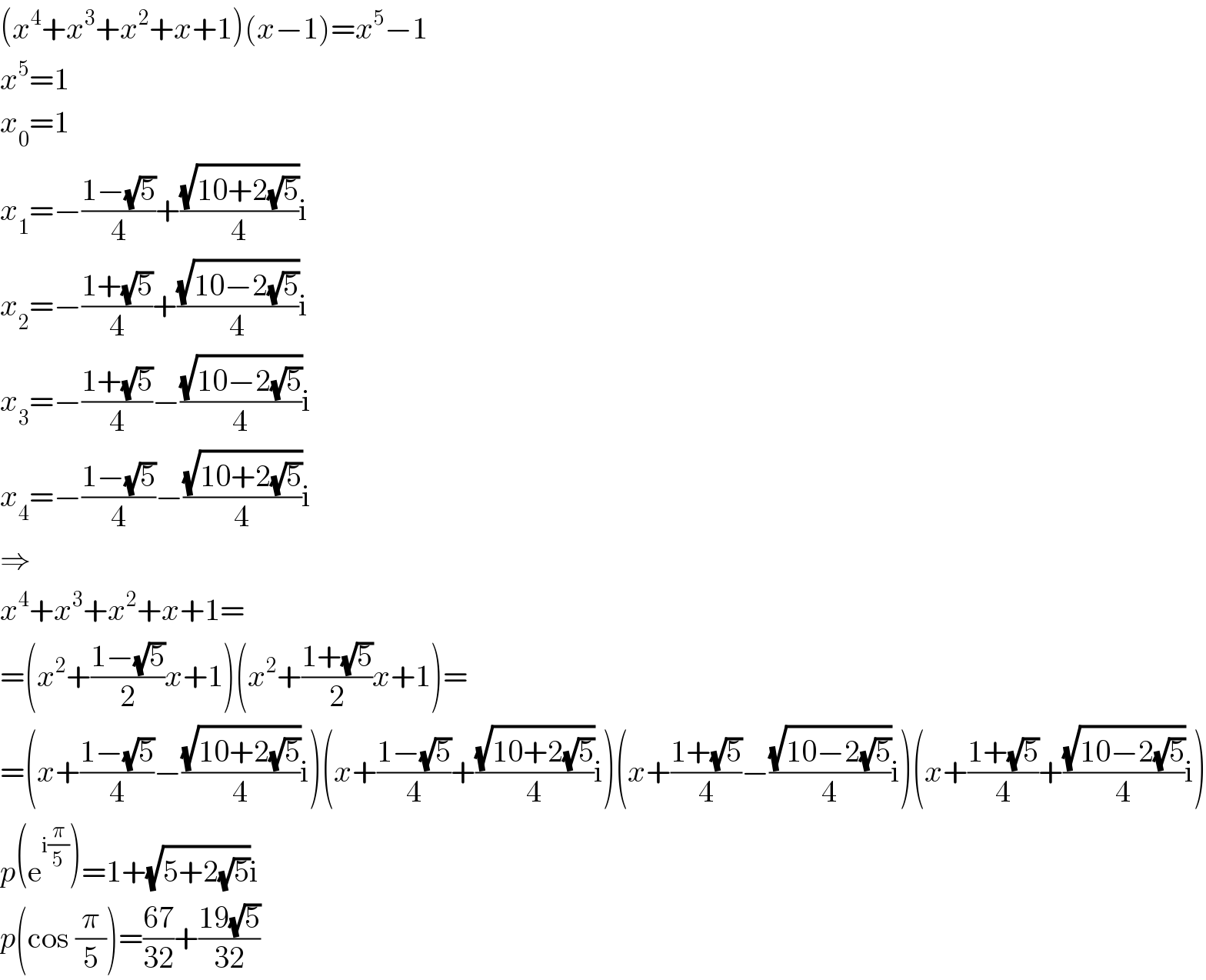
Previous in Relation and Functions Next in Relation and Functions
Question Number 67234 by prof Abdo imad last updated on 24/Aug/19
![factorise p(x)=1+x+x^2 +x^3 +x^5 inside C[x] and R[x] calculate p(e^(i(π/5)) ) and p(cos((π/5)))](Q67234.png)
$${factorise}\:{p}\left({x}\right)=\mathrm{1}+{x}+{x}^{\mathrm{2}} \:+{x}^{\mathrm{3}} \:+{x}^{\mathrm{5}} \\ $$$${inside}\:{C}\left[{x}\right]\:{and}\:{R}\left[{x}\right] \\ $$$${calculate}\:{p}\left({e}^{{i}\frac{\pi}{\mathrm{5}}} \right)\:{and}\:{p}\left({cos}\left(\frac{\pi}{\mathrm{5}}\right)\right) \\ $$
Commented by mathmax by abdo last updated on 24/Aug/19

$${sorry}\:{p}\left({x}\right)=\mathrm{1}+{x}+{x}^{\mathrm{2}} \:+{x}^{\mathrm{3}} \:+{x}^{\mathrm{4}} \\ $$
Commented by mathmax by abdo last updated on 25/Aug/19
![1)p(x)=0 ⇔ 1+x+x^2 +x^3 +x^4 =0 ⇔1−x^5 =0 and x ≠1 x^5 =1 let x =re^(iθ) (e)⇒r^5 e^(i5θ) =e^(i(2kπ)) ⇒r=1 and 5θ=2kπ ⇒ θ_k =((2kπ)/5) so the roots are z_k =e^(i(((2kπ)/5))) with k∈[[1,4]] p(x)=Π_(k=1) ^4 (x−z_k )=Π_(k=1) ^4 (x−e^(i((2kπ)/5)) ) =(x−e^(i((2π)/5)) )(x−e^(i((4π)/5)) )(x−e^(i((6π)/5)) )(x−e^(i((8π)/5)) ) but e^(i((8π)/5)) =e^(i(2π−((2π)/5))) =e^(−((i2π)/5)) and e^(i((6π)/5)) =e^(−i((4π)/5)) ⇒ p(x) =(x−e^(i((2π)/5)) )(x−e^(−i((2π)/5)) )(x−e^(i((4π)/5)) )(x−e^(−i((4π)/5)) ) =(x^2 −2Re(e^(i((2π)/5)) )x+1)(x^2 −2Re(e^(i((4π)/5)) )x+1) isthe decomposition inside C[x] we have cos((π/5)) =((1+(√5))/4) ⇒cos(((2π)/5))=2cos^2 ((π/5))−1 =2(((1+(√5))/4))^2 −1 =(1/8)(6+2(√5))−1 =((6+2(√5)−8)/8) =((−2+2(√5))/8) =(((√5)−1)/4) cos(((4π)/5)) =cos(π−(π/5)) =−cos((π/5)) ⇒ p(x) =(x^2 −(((√5)−1)/2)x +1)(x^2 +(((√5)−1)/2)x+1)](Q67305.png)
$$\left.\mathrm{1}\right){p}\left({x}\right)=\mathrm{0}\:\Leftrightarrow\:\mathrm{1}+{x}+{x}^{\mathrm{2}} \:+{x}^{\mathrm{3}} \:+{x}^{\mathrm{4}} =\mathrm{0}\:\:\Leftrightarrow\mathrm{1}−{x}^{\mathrm{5}} =\mathrm{0}\:\:\:{and}\:{x}\:\neq\mathrm{1}\: \\ $$$${x}^{\mathrm{5}} =\mathrm{1}\:\:{let}\:{x}\:={re}^{{i}\theta} \:\:\:\:\:\:\left({e}\right)\Rightarrow{r}^{\mathrm{5}} {e}^{{i}\mathrm{5}\theta} ={e}^{{i}\left(\mathrm{2}{k}\pi\right)} \:\Rightarrow{r}=\mathrm{1}\:{and}\:\mathrm{5}\theta=\mathrm{2}{k}\pi\:\Rightarrow \\ $$$$\theta_{{k}} =\frac{\mathrm{2}{k}\pi}{\mathrm{5}}\:\:{so}\:{the}\:{roots}\:{are}\:{z}_{{k}} ={e}^{{i}\left(\frac{\mathrm{2}{k}\pi}{\mathrm{5}}\right)} \:\:{with}\:{k}\in\left[\left[\mathrm{1},\mathrm{4}\right]\right] \\ $$$${p}\left({x}\right)=\prod_{{k}=\mathrm{1}} ^{\mathrm{4}} \left({x}−{z}_{{k}} \right)=\prod_{{k}=\mathrm{1}} ^{\mathrm{4}} \left({x}−{e}^{{i}\frac{\mathrm{2}{k}\pi}{\mathrm{5}}} \right)\:=\left({x}−{e}^{{i}\frac{\mathrm{2}\pi}{\mathrm{5}}} \right)\left({x}−{e}^{{i}\frac{\mathrm{4}\pi}{\mathrm{5}}} \right)\left({x}−{e}^{{i}\frac{\mathrm{6}\pi}{\mathrm{5}}} \right)\left({x}−{e}^{{i}\frac{\mathrm{8}\pi}{\mathrm{5}}} \right) \\ $$$${but}\:\:{e}^{{i}\frac{\mathrm{8}\pi}{\mathrm{5}}} \:={e}^{{i}\left(\mathrm{2}\pi−\frac{\mathrm{2}\pi}{\mathrm{5}}\right)} \:={e}^{−\frac{{i}\mathrm{2}\pi}{\mathrm{5}}} \:\:\:{and}\:{e}^{{i}\frac{\mathrm{6}\pi}{\mathrm{5}}} \:={e}^{−{i}\frac{\mathrm{4}\pi}{\mathrm{5}}} \:\Rightarrow \\ $$$${p}\left({x}\right)\:=\left({x}−{e}^{{i}\frac{\mathrm{2}\pi}{\mathrm{5}}} \right)\left({x}−{e}^{−{i}\frac{\mathrm{2}\pi}{\mathrm{5}}} \right)\left({x}−{e}^{{i}\frac{\mathrm{4}\pi}{\mathrm{5}}} \right)\left({x}−{e}^{−{i}\frac{\mathrm{4}\pi}{\mathrm{5}}} \right) \\ $$$$=\left({x}^{\mathrm{2}} −\mathrm{2}{Re}\left({e}^{{i}\frac{\mathrm{2}\pi}{\mathrm{5}}} \right){x}+\mathrm{1}\right)\left({x}^{\mathrm{2}} −\mathrm{2}{Re}\left({e}^{{i}\frac{\mathrm{4}\pi}{\mathrm{5}}} \right){x}+\mathrm{1}\right)\:\:\:{isthe}\:{decomposition} \\ $$$${inside}\:{C}\left[{x}\right] \\ $$$${we}\:{have}\:{cos}\left(\frac{\pi}{\mathrm{5}}\right)\:=\frac{\mathrm{1}+\sqrt{\mathrm{5}}}{\mathrm{4}}\:\Rightarrow{cos}\left(\frac{\mathrm{2}\pi}{\mathrm{5}}\right)=\mathrm{2}{cos}^{\mathrm{2}} \left(\frac{\pi}{\mathrm{5}}\right)−\mathrm{1} \\ $$$$=\mathrm{2}\left(\frac{\mathrm{1}+\sqrt{\mathrm{5}}}{\mathrm{4}}\right)^{\mathrm{2}} −\mathrm{1}\:=\frac{\mathrm{1}}{\mathrm{8}}\left(\mathrm{6}+\mathrm{2}\sqrt{\mathrm{5}}\right)−\mathrm{1}\:=\frac{\mathrm{6}+\mathrm{2}\sqrt{\mathrm{5}}−\mathrm{8}}{\mathrm{8}}\:=\frac{−\mathrm{2}+\mathrm{2}\sqrt{\mathrm{5}}}{\mathrm{8}}\:=\frac{\sqrt{\mathrm{5}}−\mathrm{1}}{\mathrm{4}} \\ $$$${cos}\left(\frac{\mathrm{4}\pi}{\mathrm{5}}\right)\:={cos}\left(\pi−\frac{\pi}{\mathrm{5}}\right)\:=−{cos}\left(\frac{\pi}{\mathrm{5}}\right)\:\Rightarrow \\ $$$${p}\left({x}\right)\:=\left({x}^{\mathrm{2}} −\frac{\sqrt{\mathrm{5}}−\mathrm{1}}{\mathrm{2}}{x}\:+\mathrm{1}\right)\left({x}^{\mathrm{2}} +\frac{\sqrt{\mathrm{5}}−\mathrm{1}}{\mathrm{2}}{x}+\mathrm{1}\right) \\ $$
Commented by mathmax by abdo last updated on 25/Aug/19

$${we}\:{have}\:{for}\:{x}\neq\mathrm{1}\:\:\:{p}\left({x}\right)\:=\frac{\mathrm{1}−{x}^{\mathrm{5}} }{\mathrm{1}−{x}}\:\Rightarrow\:{p}\left({e}^{{i}\frac{\pi}{\mathrm{5}}} \right)\:=\frac{\mathrm{1}−\left({e}^{\frac{{i}\pi}{\mathrm{5}}} \right)^{\mathrm{5}} }{\mathrm{1}−{e}^{{i}\frac{\pi}{\mathrm{5}}} } \\ $$$$=\frac{\mathrm{2}}{\mathrm{1}−{e}^{\frac{{i}\pi}{\mathrm{5}}} }\:\:{also}\:{we}\:{have}\:{p}\left({cos}\left(\frac{\pi}{\mathrm{5}}\right)\right)\:=\frac{\mathrm{1}−{cos}^{\mathrm{5}} \left(\frac{\pi}{\mathrm{5}}\right)}{\mathrm{1}−{cos}\left(\frac{\pi}{\mathrm{5}}\right)} \\ $$$$=\frac{\mathrm{1}−\left(\frac{\mathrm{1}+\sqrt{\mathrm{5}}}{\mathrm{4}}\right)^{\mathrm{5}} }{\mathrm{1}−\frac{\mathrm{1}+\sqrt{\mathrm{5}}}{\mathrm{4}}} \\ $$
Answered by mind is power last updated on 24/Aug/19

$${p}\left({x}\right)=\mathrm{1}+{x}+{x}^{\mathrm{2}} +{x}^{\mathrm{3}} +{x}^{\mathrm{4}} ? \\ $$$$ \\ $$$$ \\ $$
Answered by MJS last updated on 25/Aug/19

$$\left({x}^{\mathrm{4}} +{x}^{\mathrm{3}} +{x}^{\mathrm{2}} +{x}+\mathrm{1}\right)\left({x}−\mathrm{1}\right)={x}^{\mathrm{5}} −\mathrm{1} \\ $$$${x}^{\mathrm{5}} =\mathrm{1} \\ $$$${x}_{\mathrm{0}} =\mathrm{1} \\ $$$${x}_{\mathrm{1}} =−\frac{\mathrm{1}−\sqrt{\mathrm{5}}}{\mathrm{4}}+\frac{\sqrt{\mathrm{10}+\mathrm{2}\sqrt{\mathrm{5}}}}{\mathrm{4}}\mathrm{i} \\ $$$${x}_{\mathrm{2}} =−\frac{\mathrm{1}+\sqrt{\mathrm{5}}}{\mathrm{4}}+\frac{\sqrt{\mathrm{10}−\mathrm{2}\sqrt{\mathrm{5}}}}{\mathrm{4}}\mathrm{i} \\ $$$${x}_{\mathrm{3}} =−\frac{\mathrm{1}+\sqrt{\mathrm{5}}}{\mathrm{4}}−\frac{\sqrt{\mathrm{10}−\mathrm{2}\sqrt{\mathrm{5}}}}{\mathrm{4}}\mathrm{i} \\ $$$${x}_{\mathrm{4}} =−\frac{\mathrm{1}−\sqrt{\mathrm{5}}}{\mathrm{4}}−\frac{\sqrt{\mathrm{10}+\mathrm{2}\sqrt{\mathrm{5}}}}{\mathrm{4}}\mathrm{i} \\ $$$$\Rightarrow \\ $$$${x}^{\mathrm{4}} +{x}^{\mathrm{3}} +{x}^{\mathrm{2}} +{x}+\mathrm{1}= \\ $$$$=\left({x}^{\mathrm{2}} +\frac{\mathrm{1}−\sqrt{\mathrm{5}}}{\mathrm{2}}{x}+\mathrm{1}\right)\left({x}^{\mathrm{2}} +\frac{\mathrm{1}+\sqrt{\mathrm{5}}}{\mathrm{2}}{x}+\mathrm{1}\right)= \\ $$$$=\left({x}+\frac{\mathrm{1}−\sqrt{\mathrm{5}}}{\mathrm{4}}−\frac{\sqrt{\mathrm{10}+\mathrm{2}\sqrt{\mathrm{5}}}}{\mathrm{4}}\mathrm{i}\right)\left({x}+\frac{\mathrm{1}−\sqrt{\mathrm{5}}}{\mathrm{4}}+\frac{\sqrt{\mathrm{10}+\mathrm{2}\sqrt{\mathrm{5}}}}{\mathrm{4}}\mathrm{i}\right)\left({x}+\frac{\mathrm{1}+\sqrt{\mathrm{5}}}{\mathrm{4}}−\frac{\sqrt{\mathrm{10}−\mathrm{2}\sqrt{\mathrm{5}}}}{\mathrm{4}}\mathrm{i}\right)\left({x}+\frac{\mathrm{1}+\sqrt{\mathrm{5}}}{\mathrm{4}}+\frac{\sqrt{\mathrm{10}−\mathrm{2}\sqrt{\mathrm{5}}}}{\mathrm{4}}\mathrm{i}\right) \\ $$$${p}\left(\mathrm{e}^{\mathrm{i}\frac{\pi}{\mathrm{5}}} \right)=\mathrm{1}+\sqrt{\mathrm{5}+\mathrm{2}\sqrt{\mathrm{5}}}\mathrm{i} \\ $$$${p}\left(\mathrm{cos}\:\frac{\pi}{\mathrm{5}}\right)=\frac{\mathrm{67}}{\mathrm{32}}+\frac{\mathrm{19}\sqrt{\mathrm{5}}}{\mathrm{32}} \\ $$
Commented by mathmax by abdo last updated on 25/Aug/19

$${thanks}\:{sir}. \\ $$
